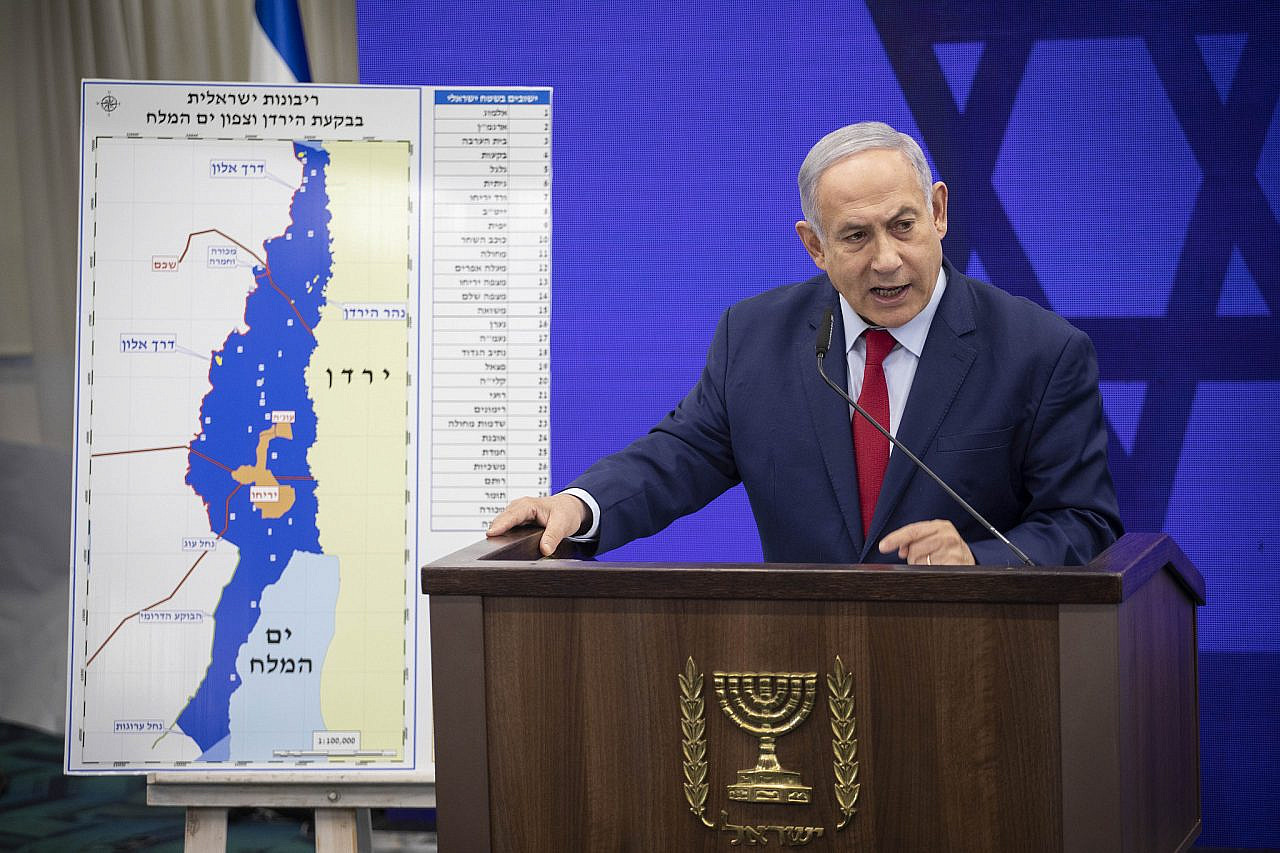A Brief Colonial History Of Ceylon(SriLanka)
Sri Lanka: One Island Two Nations
A Brief Colonial History Of Ceylon(SriLanka)
Sri Lanka: One Island Two Nations
(Full Story)
Search This Blog
Back to 500BC.
==========================
Thiranjala Weerasinghe sj.- One Island Two Nations
?????????????????????????????????????????????????Thursday, October 29, 2020
The Israeli right’s new vision of Jewish political supremacy
The settlement project's success has led to an intertwined Jewish and Palestinian population, reviving the problem Israel tried to solve through expulsion in 1948. Now, the right's priority is segregation.
First published in Hebrew on Hazman Hazeh.
Many commentators believe that over the past decade, a new trend has emerged within the dominant stream of the Israeli political right: the nation, rather than the land, is now at the heart of right-wing discourse. The territorial discourse concerning Greater Israel — that the State of Israel should control the entirety of the land from the Jordan River to the Mediterranean Sea — has weakened at the expense of a nationalist and ethnocentric discourse. And although the settler right did not initiate this narrative, it has pushed it along considerably in recent years.
This has manifested in the progression of anti-democratic legislation, incitement against Palestinian citizens of Israel and left-wing organizations and activists, and in emphasizing the idea of the “Jewish state.” An array of right-wing organizations — including the Institute for Zionist Strategy (2005), Im Tirzu (2006), The Jewish Statesmanship Center (2007), My Israel (2010), Kohelet Forum (2012), and others which were formed in the wake of the Second Intifada and the Gaza disengagement — contributed to this shift. The culmination of this process was the passing of the Jewish Nation-State Law in the Knesset in July 2018.
Some on the non-Zionist left, as well as some on the Israeli right, claim that there is nothing fundamentally new in this discourse, or even in the Jewish Nation-State Law itself: all the law does is to anchor the principles of Zionism and the values of the Declaration of Independence in a Basic Law. There is some truth to this: Zionism, as perceived by its exponents since its inception, is a movement established to serve the Jewish people by ingathering the Jews from the diaspora, the negation of exile, Hebrew labor, “redeeming” the land, and settling it.
All of the national institutions are, as their name implies, national, and not international or universal. The Zionist project is committed to a well-defined ethnic-religious group, at a defined point in space and time. In that, Zionism is not unique, of course: the commitment of nationalistic movements in general is limited and defined a priori, and therefore exclusion, marginalization of, and separation from the Other (not to mention expulsion of that Other) are inherent to them and are their by-products. For an ethno-religious-national group, self-determination is tantamount, at least potentially, to discrimination and exclusion at best, or expulsion and ethnic cleansing at worst. If there is anything unique about Zionism, it is that the combination of all these factors has persisted for an extended period of time.
Indeed, the separation underlying Jewish political supremacy in Israel has been around forever: in the Yishuv (the Jewish settlement movement before the founding of the state); in labor relations; in the Histadrut (Israel’s largest workers union); in the continuing settlement of the land after the state’s establishment; and certainly in the military rule that followed its founding, in which Israel instituted 20 years of a separate and discriminatory legal system upon the Palestinian citizens of the state, including Jim Crow laws, restrictions on their movement and dwelling, and other South Africa-style constraints, ending only in 1966. Following that came the settlement project in the occupied territories after 1967. Therefore, the argument against the opponents of the Jewish Nation-State Law, put forward by the right and echoed by the non-Zionist left, is one of continuity and consistency: the right-wing governments are merely continuing on the path of the founding fathers.
 |
Israeli Prime Minister Benjamin Netanyahu speaks with Israeli minister of Defense and leader of the Yamina party Naftali Bennett during a meeting with the heads of the right-wing parties, March 4, 2020. (Yonatan Sindel/Flash90)
Although there is much truth to these claims, they do not explain why the Jewish Nation-State Law was enacted 70 years after the state’s establishment rather than immediately thereafter. They also do not explain why the nationalist narrative, culminating in the Jewish Nation-State Law, might signal a new threshold in a long Zionist narrative and practice.
Legally enshrining Jewish privileges
The common explanation for the rise of this new discourse is that years of occupation have weakened liberal values in Israel, and the nationalist right-wing governments are stronger than ever. As such, the right is now able to implement its ethnocentric and anti-liberal ideology and weaken the democratic character of the state’s institutions.
Another explanation holds that the nationalist discourse serves to shore up a new electoral project led by the right-wing political parties. According to this view, this discourse was born out of the collapse of the Greater Israel ideology in the 1990s, when the majority of the Jewish population came to support a territorial compromise. The evacuation of the settlements from the Gaza Strip in 2005 caused a severe ideological crisis in the settler right (even though the settlement project itself continued to develop). In this reality, the nationalist discourse began to replace the worn-out territorial maximalist ideology; with this discourse, the right is attempting to form a new ideological foundation for a big political tent, while attacking the political legitimacy of the left and of Palestinian citizens of Israel through continuing incitement.
The logic is simple: if it is no longer effective to talk about the indivisible land (as belonging to the Jews), let us instead talk about the indivisible nation and mark external and internal enemies. According to this understanding, the wave of anti-democratic legislation, especially the Jewish Nation-State Law, serves as propaganda that bolsters the coalescing of the right wing around an ethnocentric agenda. In other words, the messianic-nationalist energy is directed inwards rather than outwards.
There is another explanation for the Jewish Nation-State Law, which blames the “Future Vision Documents.” One of these documents, published in December 2006 by prominent Palestinian citizens of Israel, calls for the State of Israel to shed its Jewish identity and become “a state of all its citizens.” The other documents, published by various bodies representing Palestinian citizens of Israel, follow more or less similar lines. These documents, the argument goes, raised the bar of Palestinian citizens’ demands, and the Jewish Nation-State Law constitutes a Zionist response to them.
 |
Joint List head Ayman Odeh presents the party list to the election committee at the Knesset ahead of the national election, Jerusalem, January 15, 2020. (Olivier Fitoussi/Flash90)
These are important, but insufficient, explanations. They fail to address the structural depth of Zionism as a settlement movement, for which the Jewish Nation-State Law marks a new phase. The new nationalist/ethno-religious discourse, and in particular the new law, which has been assiduously promoted for many years, is not merely a replay of history or its direct continuation. They are not merely expressions of anti-liberal and ethnocentric trends enabled by the strengthening of the right, or a mere reaction to the Palestinians’ vision documents. And they are not merely intended to create further political bias or to redefine the limits of political legitimacy.
Rather, they constitute an innovation in the Israeli right’s political project, by serving the need to actively and legally enshrine Jewish privileges, despite the fact that these exist anyway, and to give them a new constitutional framing and anchoring. This effort has successfully rallied a significant part of the Jewish-Israeli population.
During the British Mandate period, as well as during Israel’s military rule over Palestinian citizens of Israel, the separation between the Jewish and Arab populations was “natural” — a by-product of the fact that Jewish settlement developed from the start as a closed society with a political order separate from its native environment. In Israel’s early years, there was no need to “implement separation” because it had existed from the very beginning. This was an a priori fact and no law was needed to proclaim it. To this day, there are endless policies of separation acting in symbiosis, and throughout the years there was no need to point to an overriding principle as their basis. For example, in 1965 the Supreme Court affirmed the disqualification of the Palestinian Al Ard movement from running in the elections, although no law authorized Israel’s Central Election Committee to carry this out. The state’s Jewish nature was considered axiomatic and did not require legal declaration.
Today, however, the old tools that served to maintain Jewish political supremacy are no longer sufficient, and there is a need for active separation and active legitimization. Separation is no longer the result of history; rather, it must be inscribed on the political body by law and politics and must be enforced.
To understand what has changed and why active separation is now required, we have to examine the history of the very concept of separation, which formed the basis of Jewish privilege in Israeli politics.
The illusion of the two-state paradigm
In its initial decades, the Jewish state strove to contain in its margins the Palestinians who became its citizens. The state at first tried to get rid of them, first by expulsions and later by preventing their return. These activities continued until the late 1950s; the massacre in Kufr Qasem in 1956 is just one reminder of them.
A hundred years of confrontation between the Zionist settlement project and the Palestinians had to pass before any real thought was given to the possibility of a resolution, in the form of the Oslo Accords. In a certain sense, this process had already begun with the Palestinian defeats in the wars of 1948 and 1967. It continued with the later relative defeat of Israel in the 1973 Yom Kippur War, which demonstrated the limits of Israeli military power, and the First Intifada, which began in the late 1980s, that called into question Israel’s self-image of moral superiority. These events prepared the ground for a compromise, or so it was thought. For a short time, from the beginning of the 1990s until the beginning of the Netanyahu era in 2009, it seemed possible to talk about the right of self-determination for both peoples, and the two-state solution appeared to be at hand.
The notion of “two states for two peoples” that took root in the collective Israeli consciousness as an optimal, realistic, and implementable solution to the conflict created an illusion of separation between the two populations — as if they were separate political entities. Although this separation was to be fully implemented at some point in the future and was repeatedly postponed, Israelis felt that the two-state paradigm implied that the Palestinians in the occupied territories were over “there,” on the other side of the border, on the way to their independent state with an anthem, a flag, and independent prisons, outside of “our” (i.e. of the Israeli-Jewish national collective) responsibility. Israel’s decision to restrict Palestinians’ freedom of movement between the territories and Israel during the First Intifada, and the establishment of the Palestinian Authority pursuant to the Oslo Accords, contributed to this experience of separation.
With the promise of the preservation of a Jewish majority within the ’67 boundaries — albeit through a future solution not yet fully implemented on the ground — it appeared easier for Israel to move, however slowly and tentatively, along the liberal path in their attitude toward Palestinian citizens. This tendency expressed itself in the “constitutional revolution” and the policies of the Rabin government in the early to mid-1990s. These policies strengthened the “democratic” aspect of the “Jewish and democratic” equation and began to advance the status of the Palestinians as citizens with equal rights, even if only rhetorically.
One of the symptoms of this tendency was the Supreme Court’s Ka’adan ruling of 2000, which stipulated that leasing land only to Jews constituted illegal discrimination. It was an unsatisfactory verdict in its details, that was too little, too late, was not implemented, and did not change Israel’s land policies. Nevertheless, it was a sign, however feeble, of the potential to bring about change — as minimal as it may be — under different future circumstances. But even this was unbearable for many Jewish Israelis.
 |
Palestinian citizens of Israel march to commemorate the killing of 13 protesters by Israeli police in October 2000, Sakhnin, October 1, 2015. (Omar Sameer/Activestills.org)
That era, which was one of partial optimism for Palestinian citizens and for human and civil rights in Israel, continued until the beginning of the 21st century, when the Second Intifada broke out during Ehud Barak’s government and Israeli police shot dead 13 Palestinian citizens as they were protesting in October 2000. This event marked a new rupture regarding the place of Palestinians in Israeli society. A few years later, with Netanyahu at the helm, a tendency to continually incite against Palestinian citizens of Israel developed, and the cautious optimism evaporated.
From separation to segregation
After the failure to reach a permanent arrangement through the Oslo Accords came the collapse of the Camp David summit in 2000 and Barak’s declaration that there is “no partner for peace.” Then came the Gaza disengagement in 2005, followed by the rise of Hamas in the strip, Netanyahu’s new term as Prime Minister in 2009, and the ascendance of his rightist governments throughout the following decade. The two-state paradigm was progressively weakened, and one could claim that it never stood a real chance.
The crumbling of the two-state idea and the blurring of the Green Line led to a de facto single geopolitical entity in which both populations are mixed to some degree. The sharp distinction between the Palestinians “there” and the Israeli Jews “here” became hazy. Before, the two-state solution created the illusion of separation into two independent entities and removed the Palestinians from the Israeli political awareness; now, even this “calming” sensation diminished. Before, it could be claimed that the Palestinians in the territories were headed for their own separate and independent state; now, it has become clear that the territories are here, in a de facto Greater Israel, and so are the Palestinians.
Today, two groups figure prominently between the Jordan and the Mediterranean Sea: the Palestinian citizens of Israel and the Jewish settlers in the West Bank. The Palestinian citizens who managed to stay despite the Nakba lived for years on the margins of Israeli politics, which tolerated their marginal presence; for some time no institutionalized separation was required. Over the last 20 years, however, they gained power in the Knesset, in the political scene and in the economy. They were able to use legal tools in their struggle, which is an important albeit limited success.
In this situation, a state that grants a privileged status to Jews is no longer regarded as a self-evident phenomenon. The Jewish settlers, for their part, strengthened their presence in the occupied territories, and are no longer marginal or temporary inhabitants. The more their presence in the territories is perceived as natural, the more they bring the territories into Israel, creating a new geographic unity.
All this would appear to be the realization of the dream of the right-wing settler movements — the vision of a whole and united Greater Israel, de facto if not de jure. But the Israeli right has had to pay a significant price for this success: in this unified space (unified only for Jews because Palestinians cannot move freely within it), the Jewish majority is no longer self-evident. The settlement project brought back the problem that Zionism solved through expulsion in 1948.
It is now incumbent upon the settler right to provide an answer to the mixing of populations that threatens the Jewish state, and offer a positive perspective for the years to come. Expelling the Palestinians from the territories is no longer an option that can be openly discussed; neither can the Palestinians be offered full citizenship (though this possibility can be bandied about for propaganda reasons). The first possibility is untenable because of international pressure, the second because of the Jews. We are stuck in the situation that had existed during the British Mandate: one geopolitical entity with two peoples mixed together. This time, however, we are not under the Mandate, but under Israeli rule.
 |
Prime Minister Benjamin Netanyahu delivers a statement to the press regarding implementing Israeli sovereignty over the Jordan Valley and its Jewish settlements, Ramat Gan, September 10, 2019. (Hadas Parush/Flash90)
All of this helps clarify the role of the new nationalist/ethno-religious discourse: it is a discourse of segregation. According to the Zionist conception prevalent in Israel, the legitimacy of Jewish privilege within the ’67 boundaries was based largely on the existence of a Jewish majority, created by expulsion, fleeing, and prevention of return of the Palestinians. It was also based on a political order with democratic characteristics, though still limited, discriminatory, and unequal.
Yet with the crumbling of the two-state paradigm, the blurring of the Green Line and the continuing effort to extend the Jewish state over the entirety of Greater Israel, the settler right sees a need to conceptualize Jewish privileges, this time within a patently non-democratic regime between the river and the sea, which is expected to be based on a Jewish minority. The 1948 expulsion, which was a solution to the demographic problem, is no longer feasible, and therefore the need arises to establish a new-fangled apartheid regime. The Jewish Nation-State Law embodies the core of this attempt.
In contrast to the classical discourse of Greater Israel, which was focused on “unifying” two separate regimes on two separate tracts of land — Israel and the occupied territories — the new discourse is an attempt to push for the legal segregation of two populations intermixed within the same territorial framework. Therefore, this narrative and its accompanying legislation are not only a response to the collapse of the Greater Israel ideology, but also an attempt to contend with the enormous success of the settlement project, which resulted in a unified territorial unit. The segregation inspired by the law is not a division between “here” and “there” but between “us” and “them” — between Jews and Palestinians, no matter where they live between the Mediterranean and the Jordan River. It is not based on dividing the territory into two territories, but dividing the two people within one single territory.
True, the two-state paradigm is also a paradigm of separation, but it is a separation of two distinct political frameworks. Apartheid, on the other hand, separates populations that share a territory within one comprehensive political sovereign framework. Acting within a unified entity, such separation is surgical — i.e. violent and destructive.
The Jewish Nation-State Law, a far-reaching embodiment of the new nationalistic narrative, is different from all previous pieces of legislation because it links two types of segregation: the separation between Jewish and Palestinian citizens of Israel, and the separation between Jewish settlers who are citizens and Palestinian non-citizens living in the occupied territories. As such, the question of the Jewish democratic state and that of Greater Israel — the internal question and the external question — become two aspects of the same project: to legitimize the privilege of Jews over Palestinians between the river and the sea.
A single, undemocratic regime
In January 2020, just over a month before Israel’s third elections in the space of a year, Donald Trump and Benjamin Netanyahu unveiled their annexation plan. Given that this is a significant deviation from Netanyahu’s conflict management strategy — a strategy that by its very definition does not aim to terminate the conflict — does the plan fit into the thesis outlined above?
Despite the fact that the plan emerged from two unabashed right-wingers with a colonial mindset, its details are lifted from those of the center-left camp during the Oslo years. Ultimately, the plan talks about a “Palestinian state” and about not uprooting a single Palestinian, and treats the West Bank and Gaza as a single entity. It talks about sovereignty, incomplete and imperfect as it may be, for a Palestinian entity.
In reality, the plan is quite clearly talking about apartheid. It proposes geographical separation between Israeli territory and Palestinian Authority territory; however, we need to distinguish here between segregation within a whole and separation of two independent states. Segregation assumes that there is a single administrative, legal, constitutional, and conceptual structure that distinguishes between different groups within a single territorial/political unit. Separation, on the other hand, involves two independent political entities that operate independently and exist in separate political and geographical spaces. Trump’s plan ostensibly talks about separation and a Palestinian state, but in fact, it presents something that looks more like segregation under a single regime.
 |
Jewish settlers wearing costumes take part in the annual parade marking the Jewish holiday of Purim in the Hebron settlement in the occupied West Bank, March 1, 2018. (Hadas Parush/Flash90)
Setting aside, for a moment, the fact that the proposed plan was essentially spin in service of Netanyahu and Trump that might very well be history in the near future, we can identify its reliance on the basic principles of the new nationalistic/ethno-religious discourse. With the blurring of the Green Line and the return of the demographic threat, the logic of separation from the Palestinians has been abandoned and replaced with the logic of a segregating regime. It is a regime in which one group clearly dominates another; in which that domination is comprehensive and permanent, rather than temporary and security-based; and which is maintained by a legal system and reinforced by a violent and forceful state.
This dominating logic and the fact that the plan arranges for segregation, not separation, is clear when looking at the map included with the proposal. The Palestinian entity is surrounded on all sides by Israeli sovereignty: in the air and on the ground, from the north, south, east, and west. Segregation based on ethnicity, religion, and nationality, rather than on territory, is complemented by two other aspects in the plan, reflecting the demise of the Green Line: its treatment of settlers, and of Palestinian citizens in Israel.
The Oslo Accords, despite its many flaws, at least approached Palestinians’ citizenship as a given and the Jewish settlements as a problem needing to be solved. By contrast, the current plan discards territorial logic and treats Palestinians’ citizenship as a problem to be solved, and the status of settlers as a given and immutable fact. This shift also presents the possibility of the single regime’s internal borders changing — widening and narrowing as needed, according to ethnic, and not territorial, considerations. Of course, the Oslo Accords and the current plan also share certain characteristics; but this article highlights their differences in order to identify the innovation that is reminiscent of the Jewish Nation-State Law.
In essence, the differences between the settler discourse outlined above and Trump’s plan are terminological, mainly around the use of the phrase “Palestinian state.” This can be summarized as follows: at first, the two-state paradigm justified the existing reality of segregation — that is, apartheid — through continuous progress (even if mostly imagined) toward politically-negotiated separation. This was replaced in the past decade by Netanyahu’s conflict management approach, which was characterized by a reality of segregation justified by the accompanying ethno-nationalist discourse.
Finally, the Trump-Netanyahu plan arrived and offered another variation on the same theme: presenting segregation as if it were separation. This is a further example of the different forms of denying the existence of a single, undemocratic regime between the river and the sea with privileges and supremacy for one group over the other. It offers novelty only in that it departs from the conflict management paradigm in order to impose a one-sided American-Israeli vision to “end” the conflict, or rather eliminate it without solving it.


